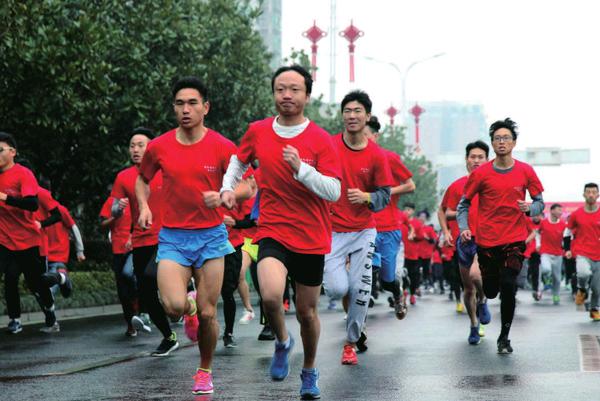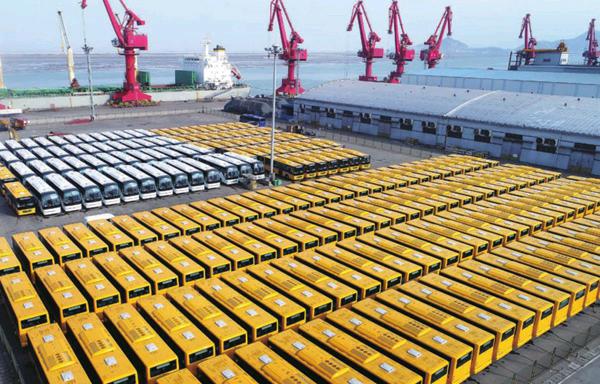Running Into 2018
Residents attend a round-the-city race in Hengyang, central Chinas Hunan Province, on January 1. Cities across China held various sporting activities to ring in the New Year.
Environment Tax
On January 1, the government began collecting a tax to better protect the environment and cut pollutant discharge as the countrys Environmental Protection Tax Law took effect.
The introduction of the tax signaled the end of the pollutant discharge fee which the authorities had been collecting for nearly 40 years.
This is Chinas fi rst tax specifi -cally designed with environmental protection in mind, which will help establish a green fi nancial and taxation system and promote pollution control and the appropriate treatment of pollutants, said Wang Jinnan, head of the Chinese Academy for Environmental Planning under the Ministry of Environmental Protection.
China had been collecting a pollutant discharge fee since 1979, however, some local governments exploited loopholes and exempted enterprises that were otherwise big contributors to fi scal revenue. For years, regulators had suggested replacing the fee system with a law which could be more effectively enforced.
Under the Environmental Protection Tax Law, which targets enterprises and public institutions that discharge listed pollutants directly into the environment, companies will pay taxes for producing noise, air and water pollutants as well as solid waste.
Tackling pollution has been described as one of the three tough battles facing China over the next three years, according to the Central Economic Work Conference in December 2017.
Ivory Trade Ban
The doors to the ivory trade in China closed on December 31, 2017.
China honors its commitment to cease the commercial processing and sale of ivory by the end of 2017, the State Forestry Administration has said.
The move affects 34 processing enterprises and 143 designated trading venues, with all of them to close, in the worlds once largest ivory market.
“The Chinese authorities will continue to clamp down on ivory collection as well as the processing, sales, transportation and smuggling of elephant tusks,” the administration said.
According to the International Union for Conservation of Nature, the population of African elephants declined by 111,000 over the past 10 years. The overall trends in the poaching of African elephants show a decline from the 2011 peak, but are still at unacceptable levels when viewed continent-wide.endprint
In 2015, China joined global efforts to announce it would phase out the ivory trade and ban imports of ivory and ivory products.
The Chinese clampdown on the ivory trade has pushed the prices of ivory down, and the number of elephants killed in the last three years down by 65 percent, according to a report by Save the Elephants.
Save the Elephants researchers said the price of ivory dropped drastically from its peak of $2,100 per kg in 2014 to $730 per kg in February 2017.
The trading ban will put ivory carving craftsmen out of business. The Chinese Government shut down 67 ivory-carving workshops and retail outlets in March 2017, and the remaining 105 were closed by the end of the year.
Ivory carving in China traces its origins to the Ming and Qing dynasties, from the 14th to the early 20th centuries, when the crafts main consumers came from the imperial court and elite scholar-offi cials.
Water Conservation
According to a senior water resources offi cial on January 2, China began construction on 16 major water conservation projects in 2017, outperforming the annual target of 15.
In 2014, the State Council, Chinas cabinet, decided to build 172 major water conservation projects in seven years and so far 122 of them are either in operation or under construction, Minister of Water Resources Chen Lei said at a meeting.
Around 2.64 trillion yuan($406.8 billion) has been invested to fi nance water conservation projects since 2013, while investment for projects still under construction exceeds 900 billion yuan ($138.7 billion).
China will continue to advance water conservation projects, including the allocation of water resources in the Pearl River Delta region and the fortifi cation of small and vulnerable reservoirs across the country in 2018, according to Chen.
Elderly Nursing
China has improved services at nursing institutions for the elderly, Minister of Civil Affairs Huang Shuxian said on January 2.
Medical services were provided in 93.4 percent of all nursing homes, and the proportion of nursing beds designed for those incapable of taking care of themselves rose from less than 30 percent in 2015 to 46.4 percent by the end of November 2017, according to Huang.
As of September 2017, the country had more than 28,000 registered nursing institutions for the elderly, with nearly 7 million beds. More than 12,500 of these institutions were private, up 7.8 percent year on year, Huang said.endprint
Of Chinas 1.4 billion people, around 230 million were aged 60 or above at the end of 2016, 16.7 percent of the total population. Among them, 51.3 percent were not living with their children.
Power Access
A sparsely populated township in southwest Chinas Tibet Autonomous Region has been connected to the state electricity grid, bringing to an end life without electricity for its 32 residents, local authorities said on January 2.
The 15-km-long, 10-kv power line, which took fi ve months to complete, is connected to the remote Yulmed Township in Luntse County via 108 electric poles which traverse a 5,000-meter-high mountain, according to the contractor, an electric power company in neighboring Qinghai Province.
Yulmed has an average elevation of 3,650 meters and its population was once reduced to one three-member household. There are currently nine households living in the township.
In 2008, the local government built a small hydropower station, but it was unable to meet increasing power demands due to the improved living standards of the residents, resulting in frequent power outages.
Intelligence Park
A technology park dedicated to the development of artifi cial intelligence will be built in Beijing in the next fi ve years, authorities said.
The park will be located in the suburban Mentougou District in west Beijing, covering 54.87 hectares, The Beijing News reported, citing a plan released by the Mentougou District Government on January 2.
With a projected investment of 13.8 billion yuan ($2.1 billion), the park is expected to attract around 400 enterprises, with an estimated annual output value of 50 billion yuan ($7.7 billion).
Enterprises in the park will focus on developing areas such as super high-speed big data, cloud computing, biometric identifi cation and deep learning. Its technologi- cal infrastructure includes a fi fthgeneration mobile network, a super computer and cloud services.
The developer of the park, a company of the Zhongguancun Development Group, will seek partnerships with Chinese and overseas universities, research institutes and large companies to establish various research centers in the park, including a national-level artifi cial intelligence lab.
Cashless Journey
Passengers use mobile payment to take the subway at the Dayanta Station in Xian, northwest Chinas Shaanxi Province, on January 1. Subway riders in the city are now able to pay for journeys by using the Xian Subway app or scanning a QR code.endprint
Traditional Art Class
A pupil from the Xichang Elementary School practices Peking Opera with the guidance of a teacher in Chengdong Town, east Chinas Jiangsu Province, on January 2. The school has set up a Peking Opera club and invites professional performers to teach students.
Innovation Friendly
On January 2, the Supreme Peoples Court issued a circular, requiring courts nationwide to create an entrepreneurial and innovation friendly legal environment.
Courts at all levels should use their judicial function to protect the legitimate interests of entrepreneurs equally according to the law, the circular said.
As long as entrepreneurship and innovation in production, management and fi nancing does not violate criminal law, it cannot be judged a crime, it said.
The circular also requires courts to strictly differentiate between the legal property and illegal gains of entrepreneurs. Courts should not confi scate or restitute property which has not been proven illegal.
The circular states that courts must protect the legitimate interests of honest and responsible entrepreneurs, and punish dishonest ones according to law.
Steel Profits
Chinas steel industry profi ts have improved despite capacity cut pressure in 2017, the Ministry of Industry and Information Technology (MIIT) said on January 3.
“In the January-November period last year, combined net profi ts in the ferrous metal smelting and rolling sector surged 180 percent year on year to 313.88 billion yuan($48 billion),” said an MIIT statement.
Meanwhile, operating revenue from primary business in the sector increased 20 percent year on year to 5.66 trillion yuan ($871 billion).
The steel sector must be focused on quality and profi t improvement while cutting overcapacity in a bid to push forward industrial upgrades, the statement said.
Loss-making “zombie enterprises” will also continue to be dealt with in order to cut ineffi cient capacity.
“Under no circumstance should iron and steel capacity be increased in 2018,” said the statement.
The industrial sector, which accounts for about one third of Chinas GDP, started to pick up in 2016 amid nationwide supplyside structural reform efforts, which include measures to trim excess production capacity, reduce inventory, cut costs, deleverage and address weak points.
Coal and steel-related companies have largely benefi ted from supply-side structural reform, which targets the reduction of outdated capacity and production costs.endprint
China plans to eliminate 100 million to 150 million tons of crude steel capacity and 500 million tons of coal in the fi ve years from 2016. The country completed its 2017 objectives for capacity cuts in both sectors, according to the National Bureau of Statistics.
Next Stop Africa
More than 500 buses are parked ready for export to Africa at the Lianyungang Port in east Chinas Jiangsu Province on January 2.
Solar Power Boost
Chinas solar power generation has picked up amid the governments efforts to expand clean energy in order to curb pollution.
The generation of solar power totaled 106.9 billion kilowatt hours in the fi rst 11 months of 2017, up 72 percent from one year earlier, according to data released by the National Energy Administration on January 2.
This was equivalent to 33 million tons of standard coal, helping to cut carbon dioxide emissions by 93 million tons, the administration said.
By the end of November, the countrys installed solar power generation capacity surged 67 percent year on year to 125.79 gigawatts, and accounted for 7.5 percent of the national total, up from 4.8 percent one year earlier.
China has been promoting green energies such as wind and solar in recent years to cope with pollution and to boost the quality of its industrial and economic growth.
Pollution control will remain a top priority, as the government has made it one of the “three tough battles” for the next three years, together with major risk prevention and poverty reduction.
The country aims to cap its coal-fi red power capacity at 1,000 gigawatts in 2020, and non-fossil fuels will account for half of the countrys total power generation by 2030.
Rail Investment
China met its annual targets for increasing railway investment in 2017, as the authorities continued to promote the construction of railways.
China spent 801 billion yuan($123 billion) on railway projects and put 3,038 km of new tracks into operation in 2017, surpassing its annual targets of 800 billion yuan of investment and 2,100 km of new lines, according to the China Railway Corp.
By the end of 2017, the total mileage of operational railways in China reached 127,000 km. Among this total, high-speed railways rose to 25,000 km from 22,000 km at the end of 2016.
The growth of railway construction comes at a time when the country is enduring continuous deceleration in the growth of fi xed assets investment.endprint
In the fi rst 11 months of 2017, fi xed assets investment grew 7.2 percent year on year, down from 8.3 percent during the same period in 2016.
China will invest steadily in transport development this year, fl at with 2017, Minister of Transport Li Xiaopeng said in late December, citing the main transport target for 2018.
In the coming three years, transport will play a bigger role in eradicating poverty and achieving greener, safer development, according to Li.
Helping Themselves
Customers peruse a self-service supermarket in Yantai, east Chinas Shandong Province, on December 30, 2017. Thanks to the technology of face recognition and radio frequency identifi cation, customers can purchase products just by walking out of the shop.
PMI Steady
Chinas manufacturing sector expanded at a slower pace in December 2017.
The countrys manufacturing purchasing managers index(PMI) came in at 51.6 in December, decelerating from 51.8 in November, according to the National Bureau of Statistics (NBS).
A reading above 50 indicates expansion, while a reading below refl ects contraction.
The index in December is on par with the annual average, still pointing to a strong resilience in Chinas growth, according to NBS senior statistician Zhao Qinghe.
Despite an overall slower expansion, the countrys manufacturing PMI has been in positive territory for 17 months in a row.
The NBS data also showed that the countrys non-manufacturing sector expanded faster in December, with non-manufacturing PMI in at 55 for December, up from 54.8 in November.
The service sector, which accounts for more than half of the countrys GDP, continued to experience steady growth, with the sectors business activity index standing at 53.4 in December, although declining 0.2 percentage points month on month.
“Early indicators for December show Chinas economy pushing into 2018 with growth steady, if unspectacular,” said Tom Orlik, Bloomberg chief Asia economist.
“Growth remains remarkably robust, underpinned by resurgent global demand, stimulus-boosted infrastructure spending and a deleveraging program that remains more honored in the breach than the observance, ” Orlik said in a research note.
Less Debt
Local governments in China issued less debt in 2017 as a result of efforts to ease the countrys debt burden.
Local governments raised 4.36 trillion yuan ($670 billion) through 1,134 instances of debt issuance in 2017, according to data from Wind, a fi nancial information provider.endprint
The value was almost 30 percent lower than the 6.05 trillion yuan ($932 billion) in debt issuance for 2016.
New debt issuance stood at 1.58 trillion yuan ($243 billion) while that issued through the debt-for-bond swap program reached 2.77 trillion yuan ($427 billion).
The swap program allows local governments to exchange highercost loans with lower-cost bonds, saving interest costs while also giving lenders higher liquidity on their receivables.
Chinas local government debt soared amid an investment and construction binge following the global fi nancial crisis in 2008. Well aware of the risks, authorities have rolled out a string of measures to reduce the local debt burden.
According to Yang Xiaojing, an analyst with credit rating agency CCXI, China is expected to complete the swap program by mid-year.
Clean and Green
A policeman installs a special license plate for a new energy car in Weinan, northwest Chinas Shaanxi Province, on December 20, 2017. A total of 265,700 green license plates, as opposed to the former blue version, have been issued for new energy vehicles in 107 cities as of December 28, 2017.endprint

